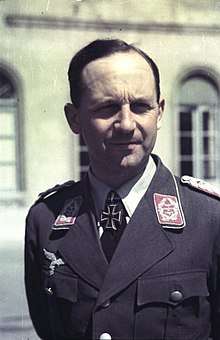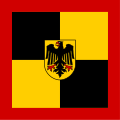Heinrich Trettner
Heinrich "Heinz" Trettner (19 September 1907 – 18 September 2006) was a German general who served during World War II and the Cold War. From 1964 to 1966 he served as Inspector General of the Bundeswehr, the head of the military of the Federal Republic of Germany. He was the last living general of the Wehrmacht.
Heinrich Trettner | |
|---|---|
 | |
| Born | 19 September 1907 Minden, German Empire |
| Died | 18 September 2006 (aged 98) Mönchengladbach, Germany |
| Allegiance | |
| Service/ | |
| Years of service | 1925–45 1956–66 |
| Rank | General |
| Commands held | 4th Parachute Division (Wehrmacht) Inspector General of the Bundeswehr |
| Battles/wars | World War II |
| Awards | Knight's Cross of the Iron Cross with Oak Leaves Great Cross of Merit |
World War II
From the start of the war until December 1940 Trettner served as Staff Officer, Operations (Ia) in the Staff of the 7th Paratroop Division until 14 June 1939. He was later appointed Chief Of Operations in the Staff of the XI. Paratroop Corps (15 December 1940 to 6 April 1942), taking part in the airborne operation on Crete. He was promoted to Chief of Staff of the XI. Paratroop Corps, but on 4 October 1943 was reassigned to head formation and become Commanding Officer of the 4th Parachute Division (Germany), a command he held until 3 May 1945 when he surrendered to the US troops.
Cold War
Trettner was released from internment in April 1948 and worked initially for the charity Caritas. In 1949 then enrolled at the University of Bonn and studied Economics and Jurisprudence, and received his diploma in Economics in 1956. Trettner then joined the Bundeswehr and was transferred to the Supreme Headquarters Allied Powers Europe SHAPE in Paris serving as commander of the logistics department until 15 September 1959.
As Inspector General, Trettner apparently had a poor relationship with Karl Gumbel, the civilian Deputy Minister of Defence, and objected to taking orders from a civil servant, Gumbel, in the absence of the Minister. He was also opposed to a ruling by the Minister, in the face of a court order, that members of the military could join a union. These factors led to his resignation, which nearly coincided with that of Werner Panitzki, the chief of staff of the Luftwaffe.[1]
Trettner was one of the umpires for the 1974 Sandhurst wargame on Operation Sea Lion. Trettner died one day before his 99th birthday. He was the last living general of the Wehrmacht.
Awards
- Cruz de Guerra de España (30 September 1938)[2]
- Medalla de la Campaña de España (1 December 1938)[2]
- Spanish Cross in Gold (6 June 1939)[2]
- Wound Badge (1939) in Black (3 March 1944)[3]
- Iron Cross (1939) 2nd Class (12 May 1940) & 1st Class (12 May 1940)[2]
- Combined Pilots-Observation Badge in Gold with Diamonds
- Knight's Cross of the Iron Cross with Oak Leaves
- Knight's Cross on 24 May 1940 as Major in the general staff and Ia (operations officer) of the 7. Flieger-Division[4]
- 586th Oak Leaves on 17 September 1944 as Generalmajor and commander of the 4. Fallschirmjäger-Division[5]
- Legion of Merit (USA) (1 November 1964)[3]
- Knight Commander of the Royal Victorian Order (Great Britain) (18 May 1965)[3]
- Grand Cross of the Order of George I (Greece) (16 July 1965)[3]
- Grand Officer of the Order of Merit of the Italian Republic (Grande Ufficiale Ordine al Merito della Repubblica Italiana) (Italy) (8 August 1965)[3]
- Grand Cross with Star and Sash of the Order of Merit of the Federal Republic of Germany (18 January 1967)[3]
- Grand Officier of the Légion d'honneur (France) (31 December 1969)[3]
References
Citations
- Hermann Hagena (May–June 1967). "Civilian Control in the German Armed Forces". Air University Review. United States Air Force. Retrieved 11 April 2008.
- Thomas & Wegmann 1986, p. 328.
- Thomas & Wegmann 1986, p. 329.
- Fellgiebel 2000, p. 426.
- Fellgiebel 2000, p. 88.
Bibliography
- Fellgiebel, Walther-Peer (2000) [1986]. Die Träger des Ritterkreuzes des Eisernen Kreuzes 1939–1945 — Die Inhaber der höchsten Auszeichnung des Zweiten Weltkrieges aller Wehrmachtteile [The Bearers of the Knight's Cross of the Iron Cross 1939–1945 — The Owners of the Highest Award of the Second World War of all Wehrmacht Branches] (in German). Friedberg, Germany: Podzun-Pallas. ISBN 978-3-7909-0284-6.
- Scherzer, Veit (2007). Die Ritterkreuzträger 1939–1945 Die Inhaber des Ritterkreuzes des Eisernen Kreuzes 1939 von Heer, Luftwaffe, Kriegsmarine, Waffen-SS, Volkssturm sowie mit Deutschland verbündeter Streitkräfte nach den Unterlagen des Bundesarchives [The Knight's Cross Bearers 1939–1945 The Holders of the Knight's Cross of the Iron Cross 1939 by Army, Air Force, Navy, Waffen-SS, Volkssturm and Allied Forces with Germany According to the Documents of the Federal Archives] (in German). Jena, Germany: Scherzers Militaer-Verlag. ISBN 978-3-938845-17-2.
- Thomas, Franz; Wegmann, Günter (1986). Die Ritterkreuzträger der Deutschen Wehrmacht 1939–1945 Teil II: Fallschirmjäger [The Knight's Cross Bearers of the German Wehrmacht 1939–1945 Part II: Paratroopers] (in German). Osnabrück, Germany: Biblio-Verlag. ISBN 978-3-7648-1461-8.
- Thomas, Franz (1998). Die Eichenlaubträger 1939–1945 Band 2: L–Z [The Oak Leaves Bearers 1939–1945 Volume 2: L–Z] (in German). Osnabrück, Germany: Biblio-Verlag. ISBN 978-3-7648-2300-9.
External links
- Heinrich Trettner in the German National Library catalogue
| Military offices | ||
|---|---|---|
| Preceded by General Friedrich Foertsch |
Chief of Staff of the Federal Armed Forces 1 January 1964 – 25 August 1966 |
Succeeded by General Ulrich de Maizière |
